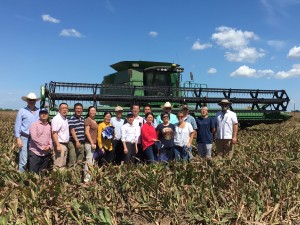Trade Team Stops in Texas—Last week, Texas Grain Sorghum Producers (TGSP) hosted a team of leading Chinese sorghum importers and feed millers during the trade teams time in Texas. Members of the team were hand-selected by U.S. Grains Council staff in China and represent organizations that purchased 2.5 million metric tons (98 million bushels) of China’s total U.S. sorghum imports in the 2014/2015 marketing year.
“It is vital that Texas Sorghum maintain clear lines of communication and strong relationships with our Chinese end users,” said Wayne Cleveland, TGSP executive director. “This trade mission allowed the team to put a face with sorghum production, to ask producers questions and learn more about effective ways to incorporate sorghum into feed rations.”
During their time here the trade team made stops in South Texas. James Kamas, Clarence Chopelas and Darrell Bowers met with the group and walked through fields, where sorghum was in varying stages leading up to harvest. The producers answered production questions and some of the team members were even able to ride a combine as sorghum was harvested. The team also visited Boening Brothers Diary, where they include popped sorghum in rations. They were also interested in learning more about handling logistics so multiple elevator stops were included as well as a tour of Louis Dreyfus and the Port of Houston.

Clarence Chopelas discussed sorghum harvest and farming practices with the team at his farm near Mathis.
A Sticky Situation— One of the more difficult questions our industry faces is how – in light of robust yields and broad international demand – can low farm prices continue to render agriculture operations unprofitable? This question, NSP’s John Duff explains in this year’s spring edition of Sorghum Growers Magazine, begets a series of narrower questions that help to explain why commodity prices remain so sticky and what conditions might engender a more bullish outlook.
In this piece, Duff identifies a handful of variables that, when weighed in relation to commodity price through a process called regression analysis, can explain most of the variance in commodity pricing. The above chart demonstrates how 83% of the variance in commodity prices can be explained by the price of gold. John goes on to show how this analysis can be used to construct a set of upper and lower bounds within which future prices can be expected to fall. It’s important to remember that these findings are predicated on a series of assumptions that are always subject to change. To better understand those assumptions and how they’re projected to affect future commodity prices, read the rest of Duff’s piece here.
Market Perspectives— The following report is from the week ending June 23, 2016. The updated export sales report will be available in next week’s edition of Market Perspectives or on July 8, 2016 via USDA/FAS’ website. Sorghum: Net sales of 84,600 MT for 2015/2016 were down 50 percent from the previous week and 38 percent from the prior 4-week average. Increases reported for China (112,600 MT, including 53,000 MT switched from unknown destinations and decreases of 1,400 MT) and Colombia (25,000 MT), were partially offset by reductions for unknown destinations (53,000 MT). Exports of 56,300 MT were up noticeably from the previous week, but down 33 percent from the prior 4-week average. The destinations were China (53,100 MT) and Mexico (3,200 MT). To read the entire Market Perspectives, provided by the US Grains Council, click here.
Comment Today on Need for Atrazine, Propazine–Atrazine and propazine are under attack by the Environmental Protection Agency. Despite science-based regulations demonstrating the safety of these chemicals for more than 50 years, the EPA’s hyperactive regulatory machine threatens to render these important crop protection tools useless in controlling weeds on 90 percent of the acres in the U.S. Weigh in on how EPA’s draft Ecological Risk Assessments put farmers at an economic disadvantage and submit your own comments before October 4, 2016, at http://sorghumgrowers.com/sorghumalert.
















